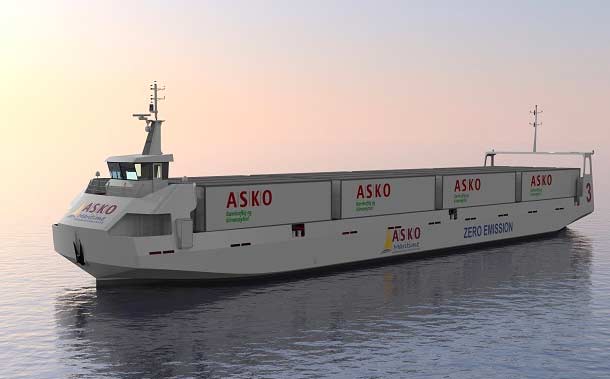As Norway’s largest grocery wholesaler, with 600+ trucks on the road daily, ASKO is used to juggling budgets to keep overheads to a minimum. So, when it came to shifting some of its road traffic volume onto the Oslo Fjord, the company’s new ASKO Maritime division decided uncrewed operations would be the most cost-efficient path forward.
Consequently, the company’s recently delivered electric ro-ro freight ferries – described by ASKO Maritime as “sea drones” and by designer Naval Dynamics as the AutoBarge series – have been developed to carry freight trailers across the fjord fully autonomously. Both AutoBarges, christened Marit and Therese, were built in India by Cochin Shipyard (CSL). Each twin will effectively spend the next two years ‘on trial’ with a four-person skeleton crew, with the goal of earning full certification for uncrewed operations at the end of this assessment period. Once certified, the ferries will switch to fully uncrewed ops, managed from a shore-based remote operating centre (ROC) in Lysaker. While Marit and Therese each feature a permanent bridge inside their bow area, this bridge module can be omitted in future builds, saving onboard space and lowering ship construction costs.
The ROC will be operated by Massterly, a joint venture formed by Kongsberg Maritime and Wilhelmsen, and will maintain communications with the AutoBarges via 4G, 5G and Kongsberg’s Maritime Broadband Radio (MBR) service.
Each ferry measures approximately 66m x 15m, weighs 600tonnes, has a design draught of 1.7m and can load, carry and discharge 16 EU-spec trailers (featuring capacities of 29tonnes each) on its open deck. ASKO Maritime’s long-term aim is to carry 150 trailers daily – a move that could cut more than 2 million road miles from its truck fleet’s journeys each year, consequently taking 5,000tonnes’ worth of CO2 emissions out of circulation annually.
Marit and Therese are each fuelled by 1,846kWh-capacity battery packs. “The battery capacity enables fully loaded sailing for four hours at 8knots,” Kongsberg tells Ship & Boat International. Each ferry’s battery pack drives an electric motor, which turns a medium-sized Schottel EcoPeller SRE 210 unit, rated 500kW. An electrically powered, 200kW Schottel PumpJet SPJ 57 has also been fitted to the bow, to provide thrust, enhance manoeuvrability and serve as a ‘take-home’ system. The operating speed for each AutoBarge is 10knots. Each sister is also fitted with Cavotec’s MoorMaster system, which uses automated vacuum pads to moor the vessel sideways to the berth (or dolphins) within 30 seconds, thereby eliminating the need for mooring lines and saving the seabed from further erosion. Cavotec also claims that the MoorMaster could slash emissions by 90% during ship berthing procedures, through reduced useage of the engine and reduced dependence on support tugs.
The CSL contract includes an option for a further two AutoBarge newbuilds – and, given ASKO’s stance on sustainability, and pending good results from the two-year trial, further orders could be on the horizon.






